|
During my teens, 20s and 30s a large number of my
Thanksgiving Days were celebrated not by congregating
with family at a dining room table heaped with food but
by being outdoors from dawn to sundown hunting quail,
pheasants, prairie chicken or ducks. Grandpa Stu,
Uncle Harold and their buddies, wow, they were into
hunting and fishing like you wouldn't believe.
Constant exposure to those great guys and their
liberated attitudes led to a certain contamination,
and if there's a doctor in the house please keep your
distance because I've no desire to be cured.
Need proof? Okay: single guy Joe (yours truly)
graciously declines four separate invitations for
Thanksgiving dinner - one from his own mother - in
favor of…going fly fishing. Now, if an early winter
storm had been in the forecast I'd have gone along
with the usual family social deal. But the forecast
was for sunny clear skies and a 66-degree daytime high.
What decided it more than anything, though, was a package
of hand-tied flies that arrived in the mail three days
before Thanksgiving - a package of panfishing flies tied
by Florida's Robert McCorquodale.
So midnight Wednesday after playing music at an old-time
country jam I drove straight to the lake and truck camped.
After setting the parking brake I took my canoe off the
roof rack, set it on the ground a few feet from shore and
loaded it with my paddling saddle, ankle rolls, two paddles,
fly rod (lined and rigged), fanny pack, PFD, ice chest and
landing net.
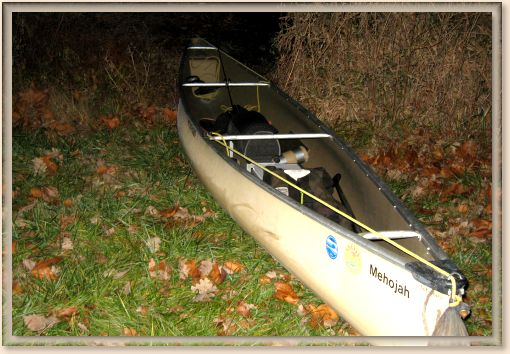
The landing net is an item I seldom carry but should
carry every trip. I stowed it now because I was
anticipating catching crappie and for crappie I need
a security blanket. Few things generate in me a darker
sense of helpless shock than carefully working a good
crappie alongside only to have it wiggle free an instant
before being lipped and lifted.
It was 32 degrees and dead calm Thanksgiving Day when I
came out of my truck at dawn, pushed my canoe into the
lake and shoved off. The area I wanted to fish lay 200
yards down the lake arm. I was halfway there, paddling
easily on mirror-smooth water, when the wind began to
rise. By the time I eased up to my target area a 15-mph
southeast breeze was sweeping the lake arm like an angry
broom. Had I waited another 15 minutes before launching,
odds are I'd have packed everything up and relocated to a
protected location. But this was the lake arm I wanted to
fish today and I was already committed so I stuck to the
original plan.
Aggravating the usual casting difficulties when fishing in
wind was a tactical problem: I wanted to fish the edge of
a stand of submerged brush and casting to it necessitated
throwing cross-wind in backhanded fashion. Not my favorite
way of casting. And after fly splashdown the wind bellied
my floating line and drastically complicated efforts to
control the fly's presentation. Thanksgiving dinner with
the family was starting to look better by the minute.
I started with a #10 Improved McGinty pulled the night
before off a card holding some one dozen flies that Robert
had sent me. After 30 minutes with no hits on the McGinty
I considered calling it a day, but decided to give another
of his flies a shot. Into the brush went an Improved Black
Gnat built on a #10 hook. To help this fly resist snagging
I left a considerable length of the knot's tag end intact
to function as a hook guard. Before long the gnat began
scoring and thoughts of leaving the lake went bye-bye.
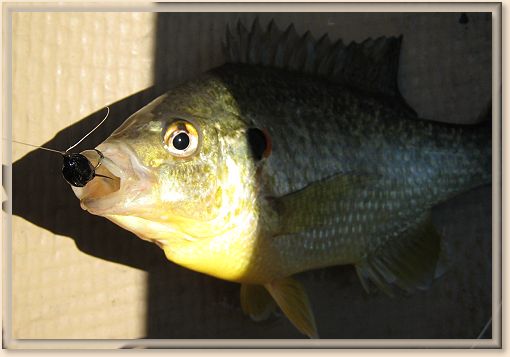

An hour of Improved Black Gnat fishing with no crappie hits
was making me antsy. I'd come here so early in the morning
thinking that crappies would be present again (like during
my last trip) but in greater numbers and they'd be eager to
bite. Unwilling to give up my hope of catching crappie, I
gambled by clipping off the gnat and tying on a bead-eye
Crappie Candy fly that Robert included.
Rolling the dice by throwing this quicker-sinking fly
into submerged brush made me nervous, but taking the
risk seemed unavoidable. If crappies were indeed
present here, they were refusing to rise and take
upper-zone presentations. I would have to go deeper
for them.
Crappie Candy, as it turned out, is also Bluegill Candy.
Redear Candy, too.
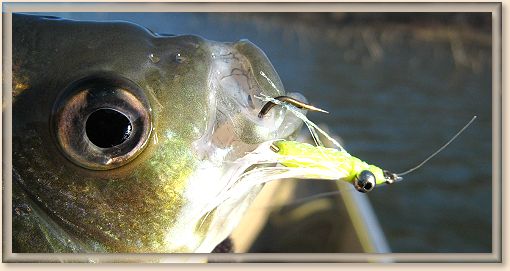
Not once did I think to lower Crappie Candy into the water
and see whether its hook rides up or down. It seemed fairly
resistant to snagging, though, which I determined by feel
when it would bump against submerged brush stems and
momentarily pause before rubbing free of the obstacle.
Finally, though, after some twenty casts it went somewhere
it shouldn't have. Grumbling, I leaned back on my rod to
test whether I could force it loose. As my rod bowed down,
suddenly something heavy pulled back while simultaneously
rising and leisurely flashing a long, tall silvery profile.
A crappie and a very big one! Overcome with excitement, I
stupidly, foolishly horsed back even harder on my rod. The
hook immediately pulled free. And that, folks, was not just
the first but also the last crappie strike I had on
Thanksgiving Day, 2006.
Not that I didn't keep trying. But now as I worked the
brush ever deeper attempting to provoke another strike
the Crappie Candy began repeatedly snagging. Naturally,
the last thing I wanted to do was break off this fly,
so each snag-up necessitated lifting both my anchors
and moving in to dislodge the fly. In a canoe that's
getting buffeted by a 15-mph wind this is no easy task.
No quiet task, either. So after about an hour of
Crappie Candy snagging and loud retrieving I switched
back to the Improved Black Gnat fly. Being a lighter
weight fly, I would try presenting it as deep as I'd
sent Crappie Candy simply by using a much slower retrieve.
"Simply" until it began snagging the woody underwater
stems, too. Then the IBG fell prey to a crosswind snag
and got broken off. At this point my frustration with
the hostile wind conditions and constant snagging began
getting to me. I left the brush and paddled to the
opposite shore of the lake arm, where I clipped off a
#16 Hare's Ear Nymph I'd used at the tail end of the
brush action. Onto the leader went my hero, Old Reliable,
a #10 flashback Hare's Ear Nymph.
But even Old Reliable was having trouble bringing home
the bacon in this wind. I was by now seriously thinking
of leaving the lake. It was around 1:00 p.m. Then I
looked far downwind and saw a patch of standing brush
sitting in a shallow-arc lakeshore pocket that, although
exposed to the wind, was not directly exposed. And the
sun was shining on it, warming it probably. A shoulder
of shoreline jutting out was deflecting just enough wind
and waves to make this spot a natural place for panfish
to congregate and ambush wind-delivered insects drifting
past. I moved to its upwind sid and during the approach
spotted below me a nice-sized panfish of some sort;
bluegill or redear, I couldn't tell which. I excitedly
anchored and began roll casting downwind into the brush
and also off to the right in deeper water.
Bringing Old Reliable slow and deep through the area a
few yards to the open water side of the brush resulted
in the capture of two large redear sunfish, the first
11-inches long (released), the second a 10-incher (kept).
Both these fish made me glad I'd brought my landing net,
as they bitterly resisted to the end.
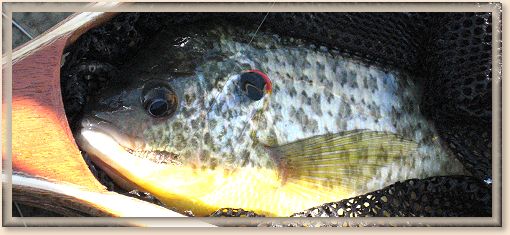
I quit the lake at 2:30 p.m. with eighteen fish in my ice
chest - ten bluegills and eight redears. In my teenager
days, or my 20s or 30s, someone in our party might have
pulled out a camera and taken a Thanksgiving Day shot of
the rooster pheasants or mallard ducks we bagged. But
Grandpa Stu and Uncle Harold are both gone now, as are
nearly all their great hunting buddies. In fact, I might
be the only one left from that group. So here's my photo
of the fruits of this year's Thanksgiving Day "hunt." It
was tough hunting, but I didn't come back empty handed.
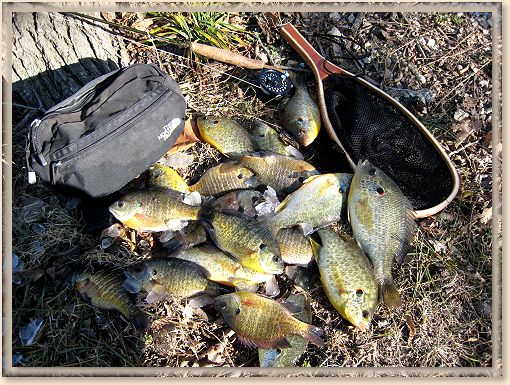
Thank you, Robert, for the flies. I only used three but
I'll be trying each one. ~ Joe
About Joe:
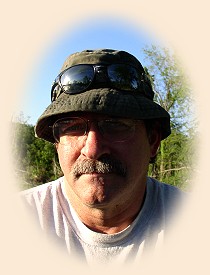 From Douglas County, Kansas, Joe is a former municipal and
federal police officer. In addition to fishing, he hunts
upland birds and waterfowl, and for the last 15 years
has pursued the sport of solo canoeing. On the nearby
Kansas River he has now logged nearly 5,000 river miles
while doing some 400 wilderness style canoe camping
trips. A musician/singer/songwriter as well, Joe's
'day job' is with the U.S. General Services Adminstration.
From Douglas County, Kansas, Joe is a former municipal and
federal police officer. In addition to fishing, he hunts
upland birds and waterfowl, and for the last 15 years
has pursued the sport of solo canoeing. On the nearby
Kansas River he has now logged nearly 5,000 river miles
while doing some 400 wilderness style canoe camping
trips. A musician/singer/songwriter as well, Joe's
'day job' is with the U.S. General Services Adminstration.
Joe at one time was a freelance photojournalist who wrote the
Sunday Outdoors column for his city newspaper. Outdoor
sports, writing and music have never earned him any money,
but remain priceless activities essential to surviving the
'day job.'
|







 From Douglas County, Kansas, Joe is a former municipal and
federal police officer. In addition to fishing, he hunts
upland birds and waterfowl, and for the last 15 years
has pursued the sport of solo canoeing. On the nearby
Kansas River he has now logged nearly 5,000 river miles
while doing some 400 wilderness style canoe camping
trips. A musician/singer/songwriter as well, Joe's
'day job' is with the U.S. General Services Adminstration.
From Douglas County, Kansas, Joe is a former municipal and
federal police officer. In addition to fishing, he hunts
upland birds and waterfowl, and for the last 15 years
has pursued the sport of solo canoeing. On the nearby
Kansas River he has now logged nearly 5,000 river miles
while doing some 400 wilderness style canoe camping
trips. A musician/singer/songwriter as well, Joe's
'day job' is with the U.S. General Services Adminstration.